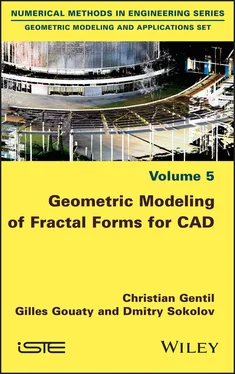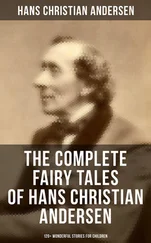Christian Gentil - Geometric Modeling of Fractal Forms for CAD
Здесь есть возможность читать онлайн «Christian Gentil - Geometric Modeling of Fractal Forms for CAD» — ознакомительный отрывок электронной книги совершенно бесплатно, а после прочтения отрывка купить полную версию. В некоторых случаях можно слушать аудио, скачать через торрент в формате fb2 и присутствует краткое содержание. Жанр: unrecognised, на английском языке. Описание произведения, (предисловие) а так же отзывы посетителей доступны на портале библиотеки ЛибКат.
- Название:Geometric Modeling of Fractal Forms for CAD
- Автор:
- Жанр:
- Год:неизвестен
- ISBN:нет данных
- Рейтинг книги:3 / 5. Голосов: 1
-
Избранное:Добавить в избранное
- Отзывы:
-
Ваша оценка:
- 60
- 1
- 2
- 3
- 4
- 5
Geometric Modeling of Fractal Forms for CAD: краткое содержание, описание и аннотация
Предлагаем к чтению аннотацию, описание, краткое содержание или предисловие (зависит от того, что написал сам автор книги «Geometric Modeling of Fractal Forms for CAD»). Если вы не нашли необходимую информацию о книге — напишите в комментариях, мы постараемся отыскать её.
In this book we present a formalism to design such complex objects for geometric aided geometry design applications. The goal of this formalism is to provide to the end user the possibility to manipulate fractal objects as a standard euclidean object with standard tools of CAD system. This formalism encompass curves, surfaces, volumes, as well as NURBS and subdivision surfaces. All theoretical and practical aspects are developed, from the design up to 3D printing.
Geometric Modeling of Fractal Forms for CAD — читать онлайн ознакомительный отрывок
Ниже представлен текст книги, разбитый по страницам. Система сохранения места последней прочитанной страницы, позволяет с удобством читать онлайн бесплатно книгу «Geometric Modeling of Fractal Forms for CAD», без необходимости каждый раз заново искать на чём Вы остановились. Поставьте закладку, и сможете в любой момент перейти на страницу, на которой закончили чтение.
Интервал:
Закладка:
3 Chapter 2Figure 2.1. “Standard” automaton for a curve. Transitions referred to by the sym...Figure 2.2. Examples of curves constructed using two transformations. The contro...Figure 2.3. A tree illustrating another possibility for connecting the subdivisi...Figure 2.4. Comparison of the effect of the two types of connection, standard an...Figure 2.5. Examples of curves constructed using three transformations whose ver...Figure 2.6. Examples of von Koch curves constructed with two transformations (to...Figure 2.7. Left-hand column: for the first figure, the first subdivision point ...Figure 2.8. Automaton describing a CA curve subdivided into a CA-type curve and ...Figure 2.9. Example of a curve obtained with two mutually referenced states acco...Figure 2.10. Tree illustrating the construction of a connection for a wired stru...Figure 2.11. Example of two wired structures built from the incidence and adjace...Figure 2.12. Examples of wired structures. The diagrams above each shape represe...Figure 2.13. Diagram of the cellular decomposition of a quadrangular surface wit...Figure 2.14. Example of subdivision of a quadrangular surface with “non-standard...Figure 2.15. Connections to build a Hilbert/Peano curve. The red circles show th...Figure 2.16. Example of a curve attempt that satisfies the adjacency relations i...Figure 2.17. Subdivision of a quadrangular surface satisfying the constraints of...Figure 2.18. Example of a Hilbert/Peano surface, defined from the subdivision of...Figure 2.19. The diagram on the right-hand side presents the quadrangular subdiv...Figure 2.20. To achieve a quadrangular surface from two subdivisions, we need to...Figure 2.21. Automaton symbolizing the subdivision system of a quadrangular surf...Figure 2.22. Example of a quadrangular surface with two subdivisions. For this i...Figure 2.23. Standard triangular subdivision. The triangular face is subdivided ...Figure 2.24. Standard triangular subdivision, but with connections differing fro...Figure 2.25. Pentagonal subdivision. On the left, the incidence relations are sy...Figure 2.26. On the left, incidence relations are symbolized using red dotted li...Figure 2.27. Cellular decomposition and subdivision of the Sierpinski triangle. ...Figure 2.28. Cellular decomposition and subdivision of the Sierpinski triangle w...Figure 2.29. Example of a Sierpinski triangle whose face, edges and vertices hav...Figure 2.30. Example of a Sierpinski triangle whose edges are uniform quadratic ...Figure 2.31. Penrose tiling of the “kite” type at iterations 1, 2, 3 and 6. For ...Figure 2.32. Topological subdivision diagram of the faces and edges representing...Figure 2.33. Example of 3D surfaces constructed from the topological subdivision...Figure 2.34. Examples of the Menger sponge, represented with three iteration lev...Figure 2.35. Example of the construction of a 2D tree structure, consisting of t...Figure 2.36. Subdivision process of the tree structure of Figure 2.35 and cell d...Figure 2.37. Automaton describing the iterative construction process of the tree...Figure 2.38. Examples of projection of the tree’s topological structure, defined...Figure 2.39. Subdivision process of a tree structure whose trunk is subdivided i...Figure 2.40. Automaton describing the iterative construction process of the tree...Figure 2.41. Example of a tree structure whose trunk (green) is not subdivided (...Figure 2.42. Simplified representation of the incidence and adjacency relations ...Figure 2.43. 3D tree built on the principle of space tiling(source: project MODI...Figure 2.44. Example of assembling fractal structures (built from an octagonal f...Figure 2.45. Example of an assembly of triangular surface structures. The basic ...Figure 2.46. Examples of assemblies of pentagonal fractal faces following a dode...Figure 2.47. Assembly of 10 3D Penrose tilings of the “kite”-type to form the co...Figure 2.48. Examples of assemblies built from Menger sponges and manufactured b...
4 Chapter 3Figure 3.1. On the left is an example of a quadratic Bezier curve, defined by th...Figure 3.2. C-IFS automaton whose attractor is a Bezier curve. This automaton si...Figure 3.3. Illustration of the self-similarity property of uniform quadratic B-...Figure 3.4. Blending B-spline functions of the second degree. Their support is o...Figure 3.5. The control points (P 0, P 1, P 2, P 3) and the knot vector (u 0, u 1, u 2,...Figure 3.6. Subdivision scheme obtained by duplication of knotsFigure 3.7. Automaton of the C-IFS representing the iterative process of a secon...Figure 3.8. From left to right: The non-uniform quadratic curve defined from fou...Figure 3.9. Automaton of the C-IFS representing the subdivision of a third-degre...Figure 3.10. The top diagram represents the knot interval vector of a curve of d...Figure 3.11. Illustration of the extraction of the knot vectors from the two cur...Figure 3.12. Subdivision process of a NURBS surface of degree 2, obtained by the...Figure 3.13. Automaton of the C-IFS representing the subdivision of a NURBS surf...Figure 3.14. C-IFS automaton whose attractor is a subdivision curve built from t...Figure 3.15. Approximations of a uniform cubic B-spline curve for levels 0 to 6:...Figure 3.16. Refinement of a regular control mesh. In red: Minimal control mesh ...Figure 3.17. Self-similarity of the refined mesh. Each of the four blue sub-mesh...Figure 3.18. Automaton of a subdivision surface for the Doo–Sabin schemeFigure 3.19. Refinement of an irregular control mesh. In red: Minimal control me...Figure 3.20. Self-similarity of the refined mesh. In blue, the four sub-meshes o...Figure 3.21. Automaton of a surface subdivision for the Doo–Sabin scheme with an...Figure 3.22. Adjacency and incidence constraints. On the left: Example of an adj...Figure 3.23. Control points defining one of the irregular edges. The irregular e...Figure 3.24. Illustration of incidence and adjacency constraints for an irregula...Figure 3.25. Representation of the topological subdivision process of an irregul...Figure 3.26. Cell decomposition of an irregular tile. The constraints are repres...Figure 3.27. Subdivision of an irregular tile with an irregular face of six side...Figure 3.28. Catmull subdivision of a regular tileFigure 3.29. The four sub-meshes of 4 × 4 control points are represented in blue...Figure 3.30. Example of an irregular mesh with a vertex of valence five. After r...Figure 3.31. Illustration of the Loop subdivision. Figure 3.31(a) is an illustra...Figure 3.32. Refinement of a regular control mesh for the Loop scheme. The struc...Figure 3.33. Self-similarity of the refined mesh for the Loop scheme. Decomposit...
5 Chapter 4Figure 4.1. Example of the user interface of “MODITERE”, the iterative modeler d...Figure 4.2. Example of orientation constraints of edges for the definition of th...Figure 4.3. Example of configuration of edge orientation for the attractor of Fi...Figure 4.4. Issues in the orientation of edges. On the left, the connection for ...Figure 4.5. Definition and application of the permutation operator. On the left,...Figure 4.6. Construction of a connection between two edges of opposite orientati...Figure 4.7. The three curves have a single internal dimension, and vertices of d...Figure 4.8. The definition of the connections for volume cells can prove complex...Figure 4.9. Illustration of the definitions of face permutations: on the left, a...Figure 4.10. Examples of construction of the topological tensor product. For a c...Figure 4.11. Example of cellular decomposition of a tensor product of two curves...Figure 4.12. Automaton of the curve aFigure 4.13. Quotient graph of curve aFigure 4.14. Automaton of a surface automatically generated from the automatons ...Figure 4.15. Quotient graph of a surface induced by adjacency relations combinin...Figure 4.16. Quotient graph obtained from adjacency relations on incidence opera...Figure 4.17. Automaton of a volume structure obtained by tensor product of three...Figure 4.18. Example of an automatically generated tree, whose leaves will perfe...Figure 4.19. First stages of subdividing a tree bordered by a curveFigure 4.20. The types of subdivisions of the tree depend on the types of edge s...Figure 4.21. Automaton representing a tree structure whose set of leaves is divi...Figure 4.22. Double trees bordered by quadrangular surfacesFigure 4.23. Example of surface obtained by the tensor product of a NURBS curve ...Figure 4.24. Automaton representing the construction of a connection structure b...Figure 4.25. Connection subdivision process. The red, green and blue mesh, respe...Figure 4.26. Connections built between different pairs of surfaces: a Doo–Sabin ...Figure 4.27. Example of a lacunar surface, co-imagined by architects (IBOIS-EPFL...Figure 4.28. Example of the definition of a 2D lacunar structure by tiling the p...Figure 4.29. Example of construction of the Menger sponge. In red, the cube is d...Figure 4.30. Lacunar structures obtained by removing the central part of a regul...Figure 4.31. Menger–Excoffier sponge with walls of the same thickness between ea...Figure 4.32. The Menger–Excoffier sponge is built from two subdivision systems o...Figure 4.33. For the Menger–Excoffier sponge, the two 3D subdivision systems are...Figure 4.34. “Triangle”-type cells have been added to the structure of Figure 4....Figure 4.35. Design of a lacunar structure from two types of cell: a tetrahedron...Figure 4.36. Two copies of the 3D lacunar topological structure obtained from th...Figure 4.37. Prototypes designed by assembly of tetrahedral structures shown in ...Figure 4.38. Illustration of the topological subdivision of the lacunar face. Fo...Figure 4.39. Lacunar face at iteration levels 3 (on the left) and 4 (in the cent...Figure 4.40. Illustration of the cellular decomposition and the subdivision proc...Figure 4.41. Example of the design of a lacunar structure, built from a truncate...Figure 4.42. Example of filling using porous volumes. On the left, the geometry ...Figure 4.43. Examples of the design of lacunar structures through the assembly o...Figure 4.44. Assembly according to the structure of a diamond. On the left, an e...Figure 4.45. Examples of rough surfaces. For a color version of this figure, see...Figure 4.46. Example of a variant of the Von Koch curve filling up almost an ent...Figure 4.47. Example of a rough, or even chaotic, surface, designed on the princ...Figure 4.48. Both surfaces are designed from the same topological structure as s...Figure 4.49. Example of a self-supporting hull, built by wood panel assembly (IB...Figure 4.50. On top, prototype of the thermal exchanger manufactured in aluminum...Figure 4.51. Construction of the display primitive linking two levels of the exc...Figure 4.52. Internal structure of the switch. For a color version of this figur...
Читать дальшеИнтервал:
Закладка:
Похожие книги на «Geometric Modeling of Fractal Forms for CAD»
Представляем Вашему вниманию похожие книги на «Geometric Modeling of Fractal Forms for CAD» списком для выбора. Мы отобрали схожую по названию и смыслу литературу в надежде предоставить читателям больше вариантов отыскать новые, интересные, ещё непрочитанные произведения.
Обсуждение, отзывы о книге «Geometric Modeling of Fractal Forms for CAD» и просто собственные мнения читателей. Оставьте ваши комментарии, напишите, что Вы думаете о произведении, его смысле или главных героях. Укажите что конкретно понравилось, а что нет, и почему Вы так считаете.












